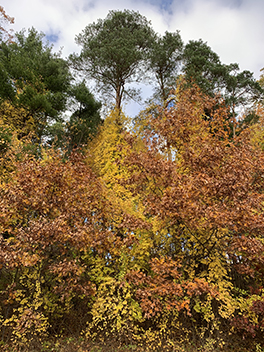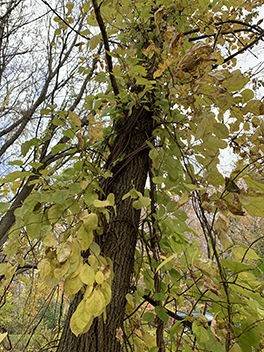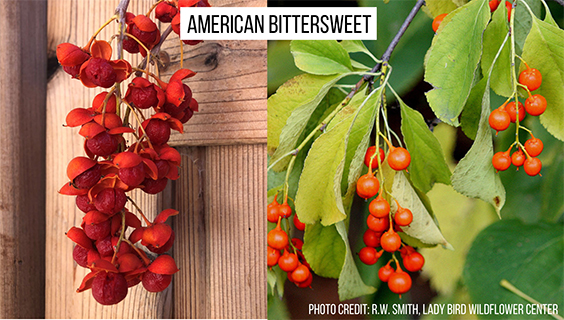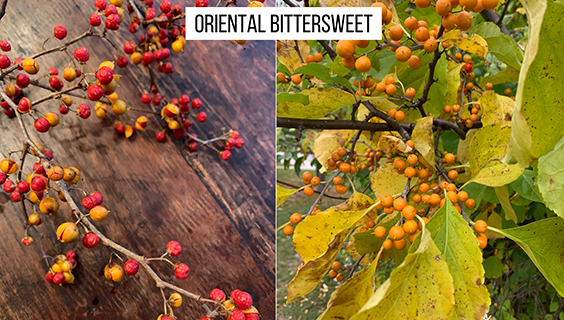More Bitter Than Sweet: The Invasive Vine That is Taking Over Kent County’s Healthy Forests and “Villages”
by Rebecca Marquardt, WORC Program Co-Chair
This past fall it was hard not to see the lemony-yellow leaved vine climbing up so many of the Oak and Hickory trees for which much of Kent County is known. Celastrus orbiculatus, otherwise known as Oriental Bittersweet, is an aggressive, non-native vine that can grow 12 feet a year, reach up to 90 feet and have a woody diameter of 10 inches.
This invasive plant has been growing and its expanding negative impacts have been affecting our country for the last 150 years. Compounding this expansion is the hybridization with our beloved native species, American Bittersweet (Celastrus scandens). Bittersweet is well revered as a beautiful vine with fruit that has an orange exterior that splits, revealing a crimson red berry inside. See below for a comparison of the native species and the invasive one.
’Autumn Revolution’ American Bittersweet*, above left, is noticeably different than the yellow-red berries of the Oriental Bittersweet, below. Notice also that the berries on the native American Bittersweet are in clusters at the end of the stem, whereas the berries on the invasive Oriental Bittersweet are dotted all along the stem.
The decorative feature of this vine comes from the fact that the female plants are prolific berry producers, which we can easily see in the barren woods during winter. In addition to the heavy seed bank below the vines and a high rate of germination, a wide range of birds eat and disperse the seeds far and wide, and those dried up seeds on the decorative wreaths we tossed into our woods germinate to become vines themselves. Wreaths of Oriental Bittersweet are technically classified as vectors of the spread of the invasive, in the same way ticks are vectors of Lyme’s disease. It is apparent that some communities have a larger problem with this invasive, based on the likelihood of the presence of wreaths. In my neighborhood, for instance, we cut down a vine with 30 years of growth rings. Martha Stewart was promoting Bittersweet wreaths in the 1990s, so putting two and two together isn’t very hard to do. It is likely Martha and her fans weren’t aware that there were two very different species of Bittersweet, and that innocent mistake is costing us significantly now.
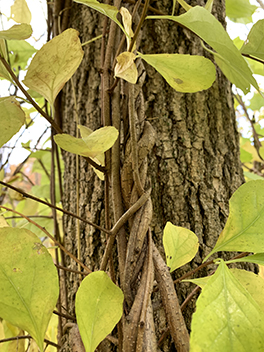 There are other reasons this invasive vine is considered aggressive. The climbing vine moves quickly, braiding with other vines to spiral up a mature tree or outright girdling younger trees that have no chance of surviving. Once the vines have reached the larger limbs of a mature tree, they add weight to the crown which makes the tree vulnerable to uprooting during a big storm. Additionally, keystone species like Oaks, when young are vulnerable to being killed as the vine successfully girdles it like a boa constrictor overpowers it’s prey.
There are other reasons this invasive vine is considered aggressive. The climbing vine moves quickly, braiding with other vines to spiral up a mature tree or outright girdling younger trees that have no chance of surviving. Once the vines have reached the larger limbs of a mature tree, they add weight to the crown which makes the tree vulnerable to uprooting during a big storm. Additionally, keystone species like Oaks, when young are vulnerable to being killed as the vine successfully girdles it like a boa constrictor overpowers it’s prey.
The strong presence of this particular vine in our community is cause for real alarm. As Wild Ones members, we know well that invasive species pose threats to the natural landscape and to the species that belong here. Oriental Bittersweet is something like cancer in our woods, or could be called “biological pollution”, as Jessie Schulte of the Kent Conservation District describes it. The longer no action is taken, the more destructive it will become. What would this area look like without its trees? Would the barred owls still want to live here? Wouldn’t you miss the fall color?
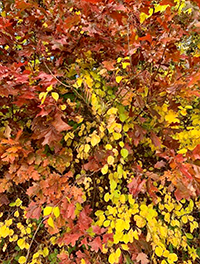 Here, we see the red leaves of a young Oak and Sumac beginning to be swallowed by the yellow Oriental Bittersweet. We cannot see the trunk of the tree because the invasive vine has braided around it and will eventually girdle it to its death.
Here, we see the red leaves of a young Oak and Sumac beginning to be swallowed by the yellow Oriental Bittersweet. We cannot see the trunk of the tree because the invasive vine has braided around it and will eventually girdle it to its death.
here is a solution. Thanks to people like Jessie and her team at Kent Conservation District (KCD), we can learn more about identification of this significant invasive vine as well as techniques and strategies to get rid of it. KCD offers trainings to landowners in land management practices such as the removal of invasive species. They can also be hired to do the hard work of removing the destructive Oriental Bittersweet from your landscape.
https://www.kentconservation.org/invasive-species-strike-team/
Many of our yards and properties have what might feel like an overwhelming prognosis, but with expertise and strategy, the KCD can prioritize and treat effectively. My family hired the KCD in the summer of 2019 to attack our infestation of Oriental Bittersweet. We have attended their trainings and have been able to pass that knowledge onto our neighbors. Eight households in our neighborhood are committed to taking back our woods from the invasive saboteur, and we will be working throughout the winter and next summer to make sure the owls and other wildlife here have a healthy home.
Ada Parks and the Kent Conservation District have an upcoming educational training on how to identify and treat Oriental Bittersweet in the winter, at Ada Township Park on Saturday, December 12 from 9:30–12.It will be outside, so be sure to come dressed for the weather and stick around to help treat some of the large infestation at the park. The KCD will also be in Cascade, at Burton Park on December 19th, 9–12.To win the battle and defeat this destructive invasive species is going to take more than just a village – please join us to learn more and lend a hand.
For more information, see:
https://www.michigan.gov/documents/dnr/Oriental_Bittersweet_389123_7.pdf
*my sister-in-law took this picture for me, from her yard in Decorah, Iowa. Even though the picture is of a showy cultivar, I wanted to be able to demonstrate that it is distinctly different from the invasive species.

